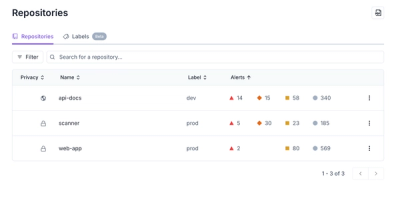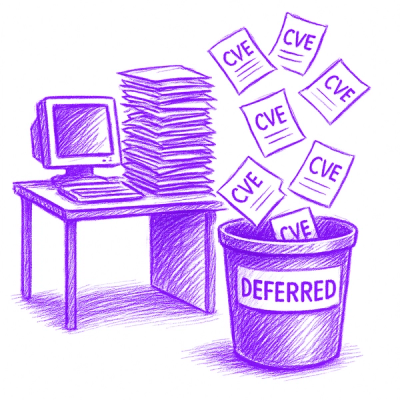
Product
Redesigned Repositories Page: A Faster Way to Prioritize Security Risk
Our redesigned Repositories page adds alert severity, filtering, and tabs for faster triage and clearer insights across all your projects.
A simple Python wrapper around qoi, the "Quite OK Image" image format. It's
pip install qoi
import numpy as np
import qoi
# Get your image as a numpy array (OpenCV, Pillow, etc. but here we just create a bunch of noise). Note: HWC ordering
rgb = np.random.randint(low=0, high=255, size=(224, 244, 3)).astype(np.uint8)
# Write it:
_ = qoi.write("/tmp/img.qoi", rgb)
# Read it and check it matches (it should, as we're lossless)
rgb_read = qoi.read("/tmp/img.qoi")
assert np.array_equal(rgb, rgb_read)
# Likewise for encode/decode to/from bytes:
bites = qoi.encode(rgb)
rgb_decoded = qoi.decode(bites)
assert np.array_equal(rgb, rgb_decoded)
# Benchmarking
from qoi.benchmark import benchmark
benchmark() # Check out the arguments if you're interested
If you want to really max out your CPU:
from concurrent.futures import ThreadPoolExecutor, wait
import numpy as np
import qoi
RGB = np.random.randint(low=0, high=255, size=(224, 244, 3)).astype(np.uint8)
def worker():
bites = bytearray(qoi.encode(RGB))
img_decoded = qoi.decode(bites)
print("Go watch your CPU utilization ...")
with ThreadPoolExecutor(8) as pool:
futures = [pool.submit(worker) for _ in range(10000)]
wait(futures)
If we consider lossless, then we're generally comparing with PNG. Yup, there are others, but they're not as common. Benchmarks:
| Test image | Method | Format | Input (kb) | Encode (ms) | Encode (kb) | Decode (ms) | SSIM |
|---|---|---|---|---|---|---|---|
| all black ('best' case) | PIL | png | 6075.0 | 37.75 | 6.0 | 16.04 | 1.00 |
| all black ('best' case) | opencv | png | 6075.0 | 23.82 | 7.7 | 17.93 | 1.00 |
| all black ('best' case) | qoi | qoi | 6075.0 | 4.13 | 32.7 | 2.67 | 1.00 |
| koi photo | PIL | png | 6075.0 | 849.07 | 2821.5 | 85.46 | 1.00 |
| koi photo | opencv | png | 6075.0 | 95.24 | 3121.5 | 44.34 | 1.00 |
| koi photo | qoi | qoi | 6075.0 | 28.37 | 3489.0 | 17.19 | 1.00 |
| random noise (worst case) | PIL | png | 6075.0 | 300.37 | 6084.5 | 46.30 | 1.00 |
| random noise (worst case) | opencv | png | 6075.0 | 63.72 | 6086.9 | 14.01 | 1.00 |
| random noise (worst case) | qoi | qoi | 6075.0 | 16.16 | 8096.1 | 7.67 | 1.00 |
So qoi isn't far off PNG in terms of compression, but 4x-20x faster to encode and 1.5x-6x faster to decode.
NB:
- There's additional overhead here with PIL images being converted back to an array as the return type, to be consistent. In some sense, this isn't fair, as PIL will be faster if you're dealing with PIL images. On the other hand, if your common use case involves arrays (e.g. for computer vision) then it's reasonable.
- Produced with
python src/qoi/benchmark.py --implementations=qoi,opencv,pil --formats=png,qoion an i7-9750H. Not going to the point of optimised OpenCV/PIL (e.g. SIMD, orpillow-simd) as the results are clear enough for this 'normal' scenario. If you want to dig further, go for it! You can easily run these tests yourself.
If we consider lossy compression, again, JPEG is usually what we're comparing with. Normally, it'd be unfair to compare QOI with JPEG as QOI is lossless, however we can do a slight trick to make QOI lossy - downscale the image, then encode it, then upsample it by the same amount after decoding. You can see we've implemented that below with a downscaling to 40% and JPEG quality of 80 (which results in them having the same visual compression i.e. SSIM). So, results (only on koi photo as the rest are less meaningful/fair for lossy):
| Test image | Method | Format | Input (kb) | Encode (ms) | Encode (kb) | Decode (ms) | SSIM |
|---|---|---|---|---|---|---|---|
| koi photo | PIL | jpg @ 80 | 6075.0 | 47.67 | 275.2 | 24.01 | 0.94 |
| koi photo | opencv | jpg @ 80 | 6075.0 | 24.03 | 275.3 | 19.58 | 0.94 |
| koi photo | qoi | qoi | 6075.0 | 23.17 | 3489.0 | 12.94 | 1.00 |
| koi photo | qoi-lossy-0.40x0.40 | qoi | 6075.0 | 4.38 | 667.5 | 2.96 | 0.94 |
Here we see that lossless qoi is losing out considerably in compression, as expected for lossy vs lossless. Also, qoi is only 1x-2x faster of encoding, and 1.5x-2x faster for decoding. However, it's important to note that this varies a lot depending on the jpeg quality specified - here it's 80 but the default for OpenCV is actually 95 which is 3x worse compression and a bit slower.
However, that's still lossy vs lossless! If you look at qoi-lossy-0.40x0.40 where we downscale as above, you can see that it can perform really well. The compression ratio is now only 3x that of JPEG (and 5x better than lossless QOI, and also the same as the default OpenCV JPEG encoding at a quality of 95), but it's so fast - 5x-10x faster encoding, and 7x-8x faster decoding.
Anyway, there are definitely use cases where qoi may still make sense over JPEG. Even lossless QOI can be worth it if size isn't an issue, as it's a bit faster. But if you use the "lossy" QOI, you're getting "comparable" (depending on JPEG quality) compression but much faster.
NB:
- See above re additional PIL overhead.
- Produced with
python src/qoi/benchmark.py --images=koi --implementations=qoi,qoi-lossy,opencv,pil --formats=jpg,qoi --qoi-lossy-scale=0.4 --jpeg-quality=0.8on an i7-9750H. Not going to the point of optimised OpenCV/PIL (e.g. SIMD, orpillow-simd,libjpeg-turbo, different JPEG qualities, etc.) as the results are clear enough for this 'normal' scenario. If you want to dig further, go for it! You can easily run these tests yourself.
git clone --recursive https://github.com/kodonnell/qoi/
USE_CYTHON=1 pip install -e .[dev]
pytest .
We use cibuildwheel to build all the wheels, which runs in a Github action. If you want to check this succeeds locally, you can try (untested):
cibuildwheel --platform linux .
Finally, when you're happy, submit a PR.
When you're on main on your local, git tag vX.X.X then git push origin vX.X.X. This pushes the tag which triggers the full GitHub Action and:
benchmark.py a CLI in setup.pyqoi CLIsetuptools_scm_git_archive?For now, this is just a simple wrapper. We'll leave the original project to do all the hard work on performance etc., and also maintaining (or not) compatibility or adding new features etc. We make no claims to do any more than that - we're basically just porting that C functionality to (C)Python.
For now, let's rock with qoi because
py in pyqoi seems redundant. For what it's worth, 3 < 5.pyqoi seems like a good name for a python-only version of QOI (useful for pypy etc.), which this isn't.qoi is generally new so let's not overthink it for now. We can always rename later if needed../src?See here and here. I didn't read all of it, but yeh, import qoi is annoying when there's also a folder called qoi.
USE_CYTHON=1?See here. Fair point.
FAQs
A simpler wrapper around qoi (https://github.com/phoboslab/qoi)
We found that qoi demonstrated a healthy version release cadence and project activity because the last version was released less than a year ago. It has 1 open source maintainer collaborating on the project.
Did you know?

Socket for GitHub automatically highlights issues in each pull request and monitors the health of all your open source dependencies. Discover the contents of your packages and block harmful activity before you install or update your dependencies.

Product
Our redesigned Repositories page adds alert severity, filtering, and tabs for faster triage and clearer insights across all your projects.

Security News
Multiple deserialization flaws in PyTorch Lightning could allow remote code execution when loading untrusted model files, affecting versions up to 2.4.0.

Security News
NVD now marks all pre-2018 CVEs as "Deferred," signaling it will no longer enrich older vulnerabilities, further eroding trust in its data.